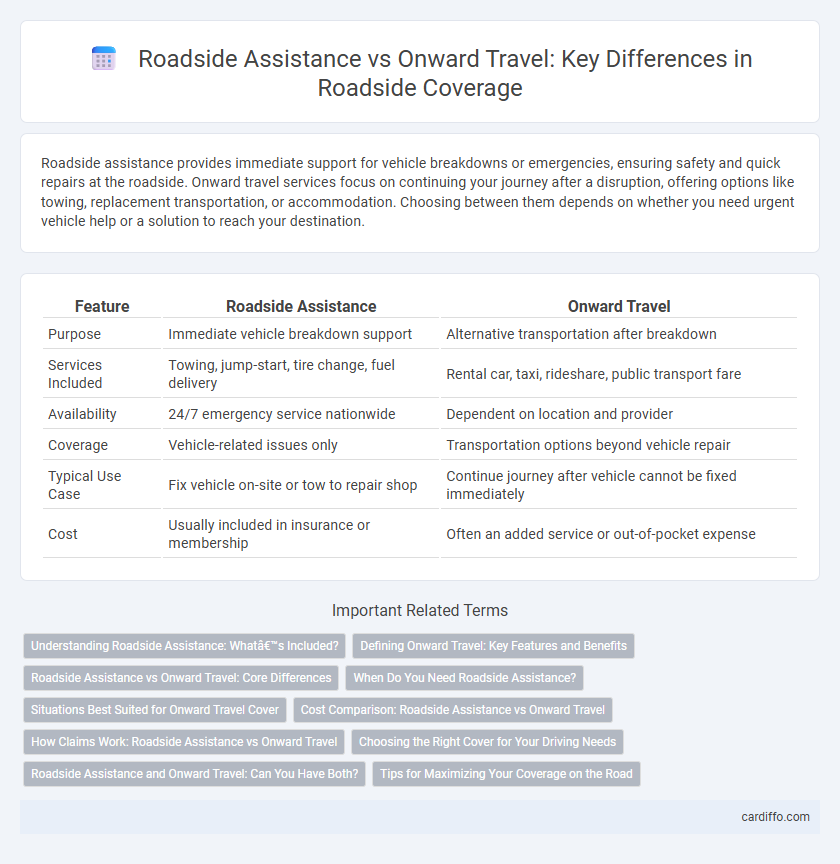Roadside assistance provides immediate support for vehicle breakdowns or emergencies, ensuring safety and quick repairs at the roadside. Onward travel services focus on continuing your journey after a disruption, offering options like towing, replacement transportation, or accommodation. Choosing between them depends on whether you need urgent vehicle help or a solution to reach your destination.
Table of Comparison
| Feature | Roadside Assistance | Onward Travel |
|---|---|---|
| Purpose | Immediate vehicle breakdown support | Alternative transportation after breakdown |
| Services Included | Towing, jump-start, tire change, fuel delivery | Rental car, taxi, rideshare, public transport fare |
| Availability | 24/7 emergency service nationwide | Dependent on location and provider |
| Coverage | Vehicle-related issues only | Transportation options beyond vehicle repair |
| Typical Use Case | Fix vehicle on-site or tow to repair shop | Continue journey after vehicle cannot be fixed immediately |
| Cost | Usually included in insurance or membership | Often an added service or out-of-pocket expense |
Understanding Roadside Assistance: What’s Included?
Roadside assistance typically includes services such as towing, tire changes, battery jump-starts, fuel delivery, and lockout recovery, ensuring drivers receive help during vehicle breakdowns. Coverage often varies by provider but generally addresses common mechanical issues and emergencies encountered on the road. Understanding these inclusions helps drivers select plans that provide comprehensive support without unexpected out-of-pocket expenses.
Defining Onward Travel: Key Features and Benefits
Onward Travel refers to the transport options provided to a stranded motorist after a vehicle breakdown, including taxi rides, car rentals, or public transportation to reach their destination. Key features include flexible travel arrangements tailored to individual needs, seamless coordination with roadside assistance providers, and coverage for expenses incurred during the journey. Benefits of Onward Travel include minimizing travel disruption, reducing stress during vehicle immobilization, and ensuring timely arrival despite unexpected breakdowns.
Roadside Assistance vs Onward Travel: Core Differences
Roadside Assistance primarily addresses immediate vehicle breakdown issues, offering services like towing, tire changes, and battery jump-starts, whereas Onward Travel focuses on providing alternative transportation solutions such as rental cars, ride services, or accommodations to continue your journey. The core difference lies in Roadside Assistance aiming to fix or move the disabled vehicle, while Onward Travel ensures the traveler reaches their destination despite the vehicle's immobility. Understanding these distinctions helps prioritize the best support based on whether vehicle repair or passenger transit is the urgent need.
When Do You Need Roadside Assistance?
Roadside assistance is essential when your vehicle breaks down unexpectedly due to mechanical failure, flat tires, dead batteries, or when you're locked out of your car. Onward travel services, on the other hand, are designed for situations where your vehicle cannot be repaired on-site, providing options like towing, rental cars, or alternative transportation to continue your journey. Knowing when to call roadside assistance helps avoid prolonged delays and ensures prompt help for emergency vehicle issues.
Situations Best Suited for Onward Travel Cover
Onward Travel cover is ideal for situations where a vehicle cannot be quickly repaired on-site, offering alternative transport options such as rental cars, taxis, or public transport to help travelers continue their journey. This type of cover supports trip continuity after breakdowns occurring far from home, during extended repairs, or in remote locations where waiting times are long. Onward Travel is best suited for motorists prioritizing minimal disruption and timely arrival at their destination despite vehicle issues.
Cost Comparison: Roadside Assistance vs Onward Travel
Roadside assistance typically costs less, averaging between $50 and $150 per service call, compared to onward travel expenses which can exceed $200 depending on distance and transportation mode. Insurance policies or membership plans often cover roadside assistance, reducing out-of-pocket costs, while onward travel expenses generally require separate budgeting. Evaluating the total expense reveals roadside assistance as the more economical option for immediate vehicle-related issues.
How Claims Work: Roadside Assistance vs Onward Travel
Claims for Roadside Assistance typically involve immediate response services such as towing, tire changes, or battery jump-starts, with verification based on service dispatch records and repair receipts. Onward Travel claims require proof of additional expenses incurred due to a breakdown, including alternative transportation or accommodation costs, supported by travel receipts and incident reports. Both claim processes emphasize timely documentation but differ in scope, with Roadside Assistance focused on vehicle repair support and Onward Travel centered on compensating travel disruptions.
Choosing the Right Cover for Your Driving Needs
Selecting the right cover between Roadside Assistance and Onward Travel depends on your primary driving concerns and the level of support you require during vehicle breakdowns. Roadside Assistance offers immediate help for minor repairs and vehicle recovery at the breakdown location, while Onward Travel provides additional benefits such as alternative transport, accommodation, or vehicle hire to continue your journey. Evaluate your driving frequency, typical travel distances, and the importance of uninterrupted mobility to choose a cover that best aligns with your specific driving needs and lifestyle.
Roadside Assistance and Onward Travel: Can You Have Both?
Roadside assistance offers immediate help with vehicle breakdowns, including towing, tire changes, and fuel delivery, ensuring safety and minimizing delays. Onward travel benefits provide alternatives like rental cars, rideshares, or accommodations to keep your trip moving after a breakdown. Many insurance plans and auto clubs allow customers to combine roadside assistance with onward travel coverage, giving comprehensive support during vehicle emergencies.
Tips for Maximizing Your Coverage on the Road
Maximize your roadside assistance and onward travel coverage by verifying the specific services included in your plan, such as towing limits, fuel delivery, and rental car reimbursements. Keep emergency contact numbers easily accessible and ensure your mobile device is charged to quickly request help during breakdowns. Regularly update your insurance provider with any travel itinerary changes to prevent claim denials and enhance response times.
Roadside Assistance vs Onward Travel Infographic

 cardiffo.com
cardiffo.com